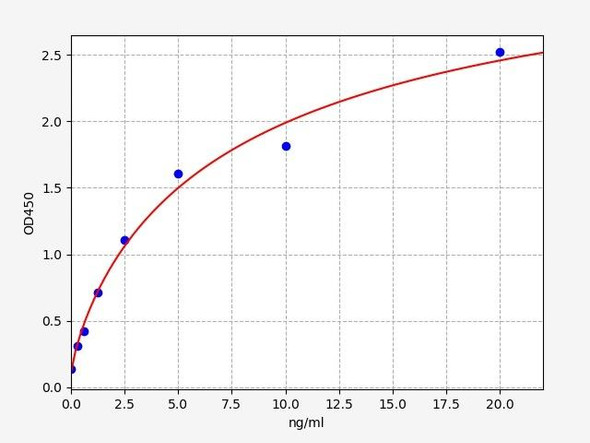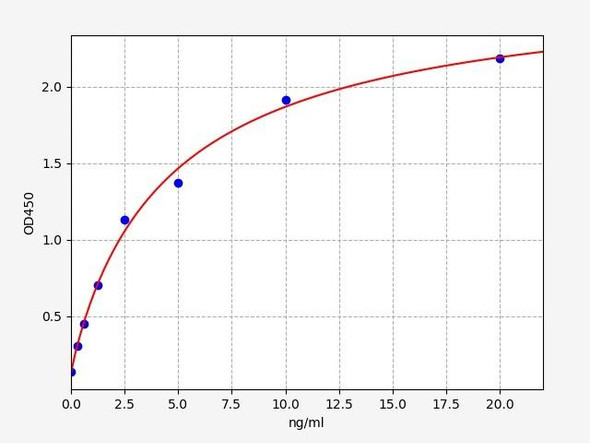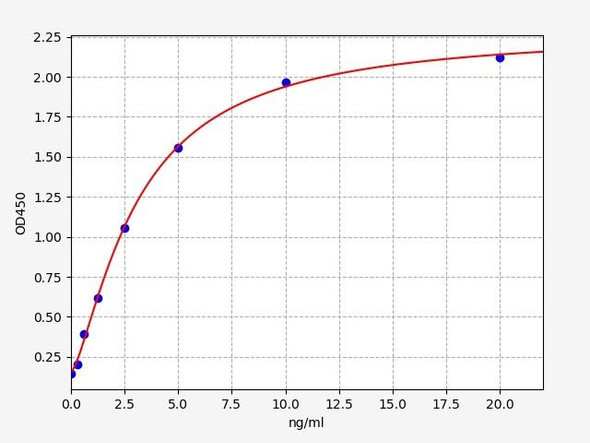Human Proinsulin ELISA Kit
- SKU:
- HUFI00316
- Product Type:
- ELISA Kit
- Size:
- 96 Assays
- Uniprot:
- P01308
- Sensitivity:
- 18.75pg/ml
- Range:
- 31.25-2000pg/ml
- ELISA Type:
- Sandwich ELISA, Double Antibody
- Synonyms:
- PI, Proinsulin
- Reactivity:
- Human
Description
| Product Name: | Human Proinsulin ELISA Kit |
| Product Code: | HUFI00316 |
| Size: | 96 Assays |
| Alias: | PI, Proinsulin |
| Detection method: | Sandwich ELISA, Double Antibody |
| Application: | This immunoassay kit allows for the in vitro quantitative determination of Human PI concentrations in serum plasma and other biological fluids. |
| Sensitivity: | 18.75pg/ml |
| Range: | 31.25-2000pg/ml |
| Storage: | 4°C for 6 months |
| Note: | For Research Use Only |
| Recovery: | Matrices listed below were spiked with certain level of Human PI and the recovery rates were calculated by comparing the measured value to the expected amount of Human PI in samples. | ||||||||||||||||
| |||||||||||||||||
| Linearity: | The linearity of the kit was assayed by testing samples spiked with appropriate concentration of Human PI and their serial dilutions. The results were demonstrated by the percentage of calculated concentration to the expected. | ||||||||||||||||
| |||||||||||||||||
| CV(%): | Intra-Assay: CV<8% Inter-Assay: CV<10% |
| Component | Quantity | Storage |
| ELISA Microplate (Dismountable) | 8×12 strips | 4°C for 6 months |
| Lyophilized Standard | 2 | 4°C/-20°C |
| Sample/Standard Dilution Buffer | 20ml | 4°C |
| Biotin-labeled Antibody(Concentrated) | 120ul | 4°C (Protect from light) |
| Antibody Dilution Buffer | 10ml | 4°C |
| HRP-Streptavidin Conjugate(SABC) | 120ul | 4°C (Protect from light) |
| SABC Dilution Buffer | 10ml | 4°C |
| TMB Substrate | 10ml | 4°C (Protect from light) |
| Stop Solution | 10ml | 4°C |
| Wash Buffer(25X) | 30ml | 4°C |
| Plate Sealer | 5 | - |
Other materials and equipment required:
- Microplate reader with 450 nm wavelength filter
- Multichannel Pipette, Pipette, microcentrifuge tubes and disposable pipette tips
- Incubator
- Deionized or distilled water
- Absorbent paper
- Buffer resevoir
| Uniprot | P01308 |
| UniProt Protein Function: | Insulin: Insulin decreases blood glucose concentration. It increases cell permeability to monosaccharides, amino acids and fatty acids. It accelerates glycolysis, the pentose phosphate cycle, and glycogen synthesis in liver. Heterodimer of a B chain and an A chain linked by two disulfide bonds. Belongs to the insulin family. |
| UniProt Protein Details: | Protein type:Secreted; Secreted, signal peptide; Hormone Chromosomal Location of Human Ortholog: 11p15.5 Cellular Component: extracellular space; Golgi lumen; endoplasmic reticulum lumen; extracellular region Molecular Function:identical protein binding; insulin-like growth factor receptor binding; protein binding; protease binding; hormone activity; insulin receptor binding Biological Process: positive regulation of nitric oxide biosynthetic process; positive regulation of vasodilation; glucose homeostasis; activation of NF-kappaB transcription factor; positive regulation of glucose import; negative regulation of protein oligomerization; regulation of protein localization; cell-cell signaling; negative regulation of gluconeogenesis; acute-phase response; regulation of transmembrane transporter activity; negative regulation of NAD(P)H oxidase activity; positive regulation of mitosis; activation of protein kinase B; positive regulation of nitric-oxide synthase activity; negative regulation of acute inflammatory response; glucose metabolic process; positive regulation of lipid biosynthetic process; positive regulation of protein amino acid autophosphorylation; positive regulation of cell growth; positive regulation of phosphoinositide 3-kinase cascade; positive regulation of peptidyl-tyrosine phosphorylation; positive regulation of cell differentiation; negative regulation of protein catabolic process; regulation of amino acid metabolic process; negative regulation of glycogen catabolic process; wound healing; positive regulation of glycogen biosynthetic process; positive regulation of cellular protein metabolic process; glucose transport; regulation of protein secretion; negative regulation of lipid catabolic process; regulation of transcription, DNA-dependent; positive regulation of MAPKKK cascade; negative regulation of vasodilation; positive regulation of cell proliferation; negative regulation of proteolysis; negative regulation of protein secretion; MAPKKK cascade; negative regulation of fatty acid metabolic process; alpha-beta T cell activation; endocrine pancreas development; G-protein coupled receptor protein signaling pathway; positive regulation of protein kinase B signaling cascade; cellular protein metabolic process; fatty acid homeostasis; positive regulation of glycolysis; insulin receptor signaling pathway; energy reserve metabolic process; positive regulation of insulin receptor signaling pathway; regulation of insulin secretion; positive regulation of DNA replication; positive regulation of cytokine secretion; positive regulation of cell migration Disease: Diabetes Mellitus, Insulin-dependent, 2; Diabetes Mellitus, Permanent Neonatal; Hyperproinsulinemia; Maturity-onset Diabetes Of The Young, Type 10 |
| NCBI Summary: | After removal of the precursor signal peptide, proinsulin is post-translationally cleaved into three peptides: the B chain and A chain peptides, which are covalently linked via two disulfide bonds to form insulin, and C-peptide. Binding of insulin to the insulin receptor (INSR) stimulates glucose uptake. A multitude of mutant alleles with phenotypic effects have been identified. There is a read-through gene, INS-IGF2, which overlaps with this gene at the 5' region and with the IGF2 gene at the 3' region. Alternative splicing results in multiple transcript variants. [provided by RefSeq, Jun 2010] |
| UniProt Code: | P01308 |
| NCBI GenInfo Identifier: | 124617 |
| NCBI Gene ID: | 3630 |
| NCBI Accession: | P01308.1 |
| UniProt Secondary Accession: | P01308,Q5EEX2, |
| UniProt Related Accession: | P01308 |
| Molecular Weight: | 110 |
| NCBI Full Name: | Insulin |
| NCBI Synonym Full Names: | insulin |
| NCBI Official Symbol: | INSÂ Â |
| NCBI Official Synonym Symbols: | IDDM; ILPR; IRDN; IDDM1; IDDM2; MODY10Â Â |
| NCBI Protein Information: | insulin; proinsulin; preproinsulin |
| UniProt Protein Name: | Insulin |
| Protein Family: | Insulin |
| UniProt Gene Name: | INSÂ Â |
| UniProt Entry Name: | INS_HUMAN |
*Note: Protocols are specific to each batch/lot. For the correct instructions please follow the protocol included in your kit.
Before adding to wells, equilibrate the SABC working solution and TMB substrate for at least 30 min at 37°C. When diluting samples and reagents, they must be mixed completely and evenly. It is recommended to plot a standard curve for each test.
| Step | Protocol |
| 1. | Set standard, test sample and control (zero) wells on the pre-coated plate respectively, and then, record their positions. It is recommended to measure each standard and sample in duplicate. Wash plate 2 times before adding standard, sample and control (zero) wells! |
| 2. | Aliquot 0.1ml standard solutions into the standard wells. |
| 3. | Add 0.1 ml of Sample / Standard dilution buffer into the control (zero) well. |
| 4. | Add 0.1 ml of properly diluted sample ( Human serum, plasma, tissue homogenates and other biological fluids.) into test sample wells. |
| 5. | Seal the plate with a cover and incubate at 37 °C for 90 min. |
| 6. | Remove the cover and discard the plate content, clap the plate on the absorbent filter papers or other absorbent material. Do NOT let the wells completely dry at any time. Wash plate X2. |
| 7. | Add 0.1 ml of Biotin- detection antibody working solution into the above wells (standard, test sample & zero wells). Add the solution at the bottom of each well without touching the side wall. |
| 8. | Seal the plate with a cover and incubate at 37°C for 60 min. |
| 9. | Remove the cover, and wash plate 3 times with Wash buffer. Let wash buffer rest in wells for 1 min between each wash. |
| 10. | Add 0.1 ml of SABC working solution into each well, cover the plate and incubate at 37°C for 30 min. |
| 11. | Remove the cover and wash plate 5 times with Wash buffer, and each time let the wash buffer stay in the wells for 1-2 min. |
| 12. | Add 90 µl of TMB substrate into each well, cover the plate and incubate at 37°C in dark within 10-20 min. (Note: This incubation time is for reference use only, the optimal time should be determined by end user.) And the shades of blue can be seen in the first 3-4 wells (with most concentrated standard solutions), the other wells show no obvious color. |
| 13. | Add 50 µl of Stop solution into each well and mix thoroughly. The color changes into yellow immediately. |
| 14. | Read the O.D. absorbance at 450 nm in a microplate reader immediately after adding the stop solution. |
When carrying out an ELISA assay it is important to prepare your samples in order to achieve the best possible results. Below we have a list of procedures for the preparation of samples for different sample types.
| Sample Type | Protocol |
| Serum | If using serum separator tubes, allow samples to clot for 30 minutes at room temperature. Centrifuge for 10 minutes at 1,000x g. Collect the serum fraction and assay promptly or aliquot and store the samples at -80°C. Avoid multiple freeze-thaw cycles. If serum separator tubes are not being used, allow samples to clot overnight at 2-8°C. Centrifuge for 10 minutes at 1,000x g. Remove serum and assay promptly or aliquot and store the samples at -80°C. Avoid multiple freeze-thaw cycles. |
| Plasma | Collect plasma using EDTA or heparin as an anticoagulant. Centrifuge samples at 4°C for 15 mins at 1000 × g within 30 mins of collection. Collect the plasma fraction and assay promptly or aliquot and store the samples at -80°C. Avoid multiple freeze-thaw cycles. Note: Over haemolysed samples are not suitable for use with this kit. |
| Urine & Cerebrospinal Fluid | Collect the urine (mid-stream) in a sterile container, centrifuge for 20 mins at 2000-3000 rpm. Remove supernatant and assay immediately. If any precipitation is detected, repeat the centrifugation step. A similar protocol can be used for cerebrospinal fluid. |
| Cell culture supernatant | Collect the cell culture media by pipette, followed by centrifugation at 4°C for 20 mins at 1500 rpm. Collect the clear supernatant and assay immediately. |
| Cell lysates | Solubilize cells in lysis buffer and allow to sit on ice for 30 minutes. Centrifuge tubes at 14,000 x g for 5 minutes to remove insoluble material. Aliquot the supernatant into a new tube and discard the remaining whole cell extract. Quantify total protein concentration using a total protein assay. Assay immediately or aliquot and store at ≤ -20 °C. |
| Tissue homogenates | The preparation of tissue homogenates will vary depending upon tissue type. Rinse tissue with 1X PBS to remove excess blood & homogenize in 20ml of 1X PBS (including protease inhibitors) and store overnight at ≤ -20°C. Two freeze-thaw cycles are required to break the cell membranes. To further disrupt the cell membranes you can sonicate the samples. Centrifuge homogenates for 5 mins at 5000xg. Remove the supernatant and assay immediately or aliquot and store at -20°C or -80°C. |
| Tissue lysates | Rinse tissue with PBS, cut into 1-2 mm pieces, and homogenize with a tissue homogenizer in PBS. Add an equal volume of RIPA buffer containing protease inhibitors and lyse tissues at room temperature for 30 minutes with gentle agitation. Centrifuge to remove debris. Quantify total protein concentration using a total protein assay. Assay immediately or aliquot and store at ≤ -20 °C. |
| Breast Milk | Collect milk samples and centrifuge at 10,000 x g for 60 min at 4°C. Aliquot the supernatant and assay. For long term use, store samples at -80°C. Minimize freeze/thaw cycles. |










